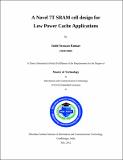Novel 7T SRAM cell design for low power cache applications
Abstract
Scaling in integrated circuit technology directly paves way to increased package density,
thereby increasing onchip power. With continuous scaling, low power design techniques
results in efficient use of silicon die. Semiconductor memories are most important
subsystems of modern digital systems. Modern IC’s allocate 70% of the total chip area to
memory design. SRAM is used as on chip cache memory. A major part of the power
consumption in any memory architecture is due to charging and discharging of highly
capacitive bitlines and wordlines. Existing techniques mainly concentrated on the reduction of
power due to the capacitive bitlines and wordlines. In this thesis, a new 7T SRAM cell has
been proposed with a single bitline architecture which reduces the dynamic power
consumption to a great extent. This proposed design resulted in power reduction of write ‘0’
and read ‘0’ operation, based on the fact that the majority of the cache writes are 0’s. A
memory array of size 256Kb (512x512) was designed using the basic 6T SRAM and propsed
7T SRAM cell to carry out the simulations and compare the results for power optimization.
The simulations were done using Cadence Virtuoso (ADE) tool in gpdk180 library using
0.18μm technology. With the proposed SRAM cell implementing 256Kb memory array,
reduction of write power (approximately 80%) and read power (approximately 55%) is
achieved compared to conventional SRAM array. There is an area overhead of 28.76% using
the present 180nm technology.
Collections
- M Tech Dissertations [923]

